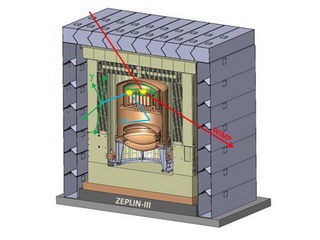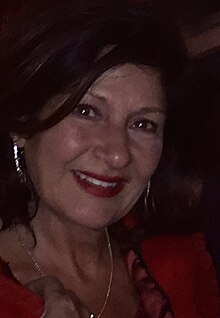
Dark matter is a hypothetical form of matter thought to be the predominant type of matter in the universe. It is called "dark" because it does not appear to interact with the electromagnetic field, which means it does not absorb, reflect, or emit electromagnetic radiation and is, therefore, difficult to detect. Its existence is implied by various astrophysical observations which cannot be explained by general relativity unless more matter is present than can be seen. Evidence for dark matter comes from many different angles, such as galaxy dynamics and formation, gravitational lensing, and the cosmic microwave background, along with astronomical observations of the observable universe's current structure, the formation and evolution of galaxies, mass location during galactic collisions, and the motion of galaxies within galaxy clusters. In the standard Lambda-CDM model of cosmology, the mass–energy content of the universe is 5% ordinary matter, 26.8% dark matter, and 68.2% a form of energy known as dark energy. Thus, dark matter constitutes 85% of the total mass, while dark energy and dark matter constitute 95% of the total mass–energy content.
Weakly interacting massive particles (WIMPs) are hypothetical particles that are one of the proposed candidates for dark matter.
An axion is a hypothetical elementary particle originally postulated by the Peccei–Quinn theory in 1977 to resolve the strong CP problem in quantum chromodynamics (QCD). If axions exist and have low mass within a specific range, they are of interest as a possible component of cold dark matter.
The XENON dark matter research project, operated at the Italian Gran Sasso National Laboratory, is a deep underground detector facility featuring increasingly ambitious experiments aiming to detect hypothetical dark matter particles. The experiments aim to detect particles in the form of weakly interacting massive particles (WIMPs) by looking for rare nuclear recoil interactions in a liquid xenon target chamber. The current detector consists of a dual phase time projection chamber (TPC).
The ArDM Experiment was a particle physics experiment based on a liquid argon detector, aiming at measuring signals from WIMPs, which may constitute the Dark Matter in the universe. Elastic scattering of WIMPs from argon nuclei is measurable by observing free electrons from ionization and photons from scintillation, which are produced by the recoiling nucleus interacting with neighbouring atoms. The ionization and scintillation signals can be measured with dedicated readout techniques, which constituted a fundamental part of the detector.

Katherine Freese is a theoretical astrophysicist. She is currently a professor of physics at the University of Texas at Austin, where she holds the Jeff and Gail Kodosky Endowed Chair in Physics. She is known for her work in theoretical cosmology at the interface of particle physics and astrophysics.

The Large Underground Xenon experiment (LUX) aimed to directly detect weakly interacting massive particle (WIMP) dark matter interactions with ordinary matter on Earth. Despite the wealth of (gravitational) evidence supporting the existence of non-baryonic dark matter in the Universe, dark matter particles in our galaxy have never been directly detected in an experiment. LUX utilized a 370 kg liquid xenon detection mass in a time-projection chamber (TPC) to identify individual particle interactions, searching for faint dark matter interactions with unprecedented sensitivity.
The chameleon is a hypothetical scalar particle that couples to matter more weakly than gravity, postulated as a dark energy candidate. Due to a non-linear self-interaction, it has a variable effective mass which is an increasing function of the ambient energy density—as a result, the range of the force mediated by the particle is predicted to be very small in regions of high density but much larger in low-density intergalactic regions: out in the cosmos chameleon models permit a range of up to several thousand parsecs. As a result of this variable mass, the hypothetical fifth force mediated by the chameleon is able to evade current constraints on equivalence principle violation derived from terrestrial experiments even if it couples to matter with a strength equal or greater than that of gravity. Although this property would allow the chameleon to drive the currently observed acceleration of the universe's expansion, it also makes it very difficult to test for experimentally.
Manfred Lindner is a German physicist and director at the Max Planck Institute for Nuclear Physics in Heidelberg, Germany. He conducts basic research in particle and astro-particle physics.

The ZEPLIN-III dark matter experiment attempted to detect galactic WIMPs using a 12 kg liquid xenon target. It operated from 2006 to 2011 at the Boulby Underground Laboratory in Loftus, North Yorkshire. This was the last in a series of xenon-based experiments in the ZEPLIN programme pursued originally by the UK Dark Matter Collaboration (UKDMC). The ZEPLIN-III project was led by Imperial College London and also included the Rutherford Appleton Laboratory and the University of Edinburgh in the UK, as well as LIP-Coimbra in Portugal and ITEP-Moscow in Russia. It ruled out cross-sections for elastic scattering of WIMPs off nucleons above 3.9 × 10−8 pb from the two science runs conducted at Boulby.
The Particle and Astrophysical Xenon Detector, or PandaX, is a dark matter detection experiment at China Jinping Underground Laboratory (CJPL) in Sichuan, China. The experiment occupies the deepest underground laboratory in the world, and is among the largest of its kind.
The Cryogenic Low-Energy Astrophysics with Noble liquids (CLEAN) experiment by the DEAP/CLEAN collaboration is searching for dark matter using noble gases at the SNOLAB underground facility. CLEAN has studied neon and argon in the MicroCLEAN prototype, and running the MiniCLEAN detector to test a multi-ton design.

The LUX-ZEPLIN (LZ) Experiment is a next-generation dark matter direct detection experiment hoping to observe weakly interacting massive particles (WIMP) scatters on nuclei. It was formed in 2012 by combining the LUX and ZEPLIN groups. It is currently a collaboration of 30 institutes in the US, UK, Portugal and South Korea. The experiment is located at the Sanford Underground Research Facility (SURF) in South Dakota, and is managed by the United States Department of Energy's (DOE) Lawrence Berkeley National Lab.

]
Kerstin Perez is an Associate Professor of Particle Physics at the Massachusetts Institute of Technology. She is interested in physics beyond the standard model. She leads the silicon detector program for the General AntiParticle Spectrometer (GAPS) and the high-energy X-ray analysis community for the NuSTAR telescope array.
Laura Baudis (1969) is a Romanian-born Swiss particle astrophysicist. She is employed as a full professor by the University of Zurich, Switzerland. Her research focuses on dark matter and neutrino physics. She is a member of the science strategy team for XENON as well as the CERN Scientific Policy Committee (2016–18) and the PSI Research Committee for Particle Physics.

Jocelyn Monroe is an American experimental particle physicist who is a professor at Royal Holloway, University of London. Her research considers the development of novel detectors as part of the search for dark matter. In 2016 she was honoured with the Breakthrough Prize in Fundamental Physics for her work on the Sudbury Neutrino Observatory.

ANAIS is a dark matter direct detection experiment located at the Canfranc Underground Laboratory (LSC), in Spain.
Direct detection of dark matter is the science of attempting to directly measure dark matter collisions in Earth-based experiments. Modern astrophysical measurements, such as from the Cosmic Microwave Background, strongly indicate that 85% of the matter content of the universe is unaccounted for. Although the existence of dark matter is widely believed, what form it takes or its precise properties has never been determined. There are three main avenues of research to detect dark matter: attempts to make dark matter in accelerators, indirect detection of dark matter annihilation, and direct detection of dark matter in terrestrial labs. The founding principle of direct dark matter detection is that since dark matter is known to exist in the local universe, as the Earth, Solar System, and the Milky Way Galaxy carve out a path through the universe they must intercept dark matter, regardless of what form it takes.
Daniel S. Akerib is an American particle physicist and astrophysicist. He was elected in 2008 a fellow of the American Physical Society (APS).








